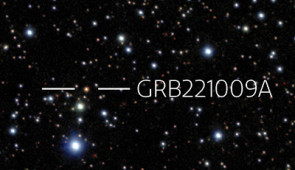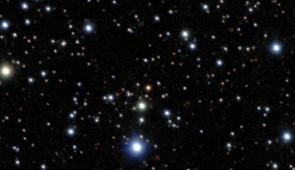
Brightest-ever gamma-ray burst breaks records
Once-in-a-lifetime event was likely generated by a massive star collapse
- Link to: Northwestern Now Story
- Newly spotted gamma-ray burst is the brightest ever recorded by a factor of 10 or more
- Astronomers will observe the GRB for months to determine why the explosion was so energetic
- Record-breaking event has united the international astronomy community
EVANSTON, Ill. — An international team of astronomers, including Northwestern University astrophysicists, has detected the brightest gamma-ray burst (GRB) ever recorded.
Affectionately referred to as the B.O.A.T. (“brightest of all time”), the powerful explosion occurred approximately 2.4 billion light-years away from Earth, in the direction of the constellation Sagitta. Astrophysicists first detected the GRB, which was a few hundred seconds in duration, in gamma-ray light on Oct. 9.
In the early morning hours of Friday, Oct. 14, Northwestern’s Jillian Rastinejad used the Gemini Multi-Object Spectrograph, mounted on the Gemini-South telescope in Chile, to study the evolving event (dubbed GRB221009A) and its resulting afterglow in optical light. At the same time, a graduate student at George Washington University also observed GRB221009A with a near-infrared imaging spectrograph.
Now — eight days after the event occurred — the teams hypothesize that the record-breaking burst was generated by a massive star collapsing and giving birth to a black hole. More analysis is needed, however, to confirm the GRB’s origins and determine what caused this particular GRB to emit so much energy.
“This GRB is an extraordinarily rare event,” said Rastinejad, a Northwestern Ph.D. student. “It was so bright that it triggered the Swift gamma-ray telescopes twice and fully saturated the detectors — something I haven’t seen in my time observing GRBs.”
“As long as we have been able to detect GRBs, there is no question that this GRB is the brightest that we have ever witnessed by a factor of 10 or more,” said Northwestern astrophysicist Wen-fai Fong, who advises Rastinejad. “Because the GRB is so bright, we expect to be able to monitor it for several months. It’s currently in its infancy, and we are learning more with each new passing observation. Unfortunately, we only have about a month or so before it goes behind the sun. But when it comes out of solar conjunction early next year, we will be excited to see the GRB as a messy ‘toddler.’ Then, we will be ready and waiting to capture it on camera.”
Fong is an assistant professor of physics and astronomy in Northwestern’s Weinberg College of Arts and Sciences and a key member of the Center for Interdisciplinary Exploration and Research in Astrophysics (CIERA). Rastinejad is a Ph.D. student in CIERA and member of Fong’s research group.
Although long GRBs are typically generated by massive stars collapsing, astronomers around the world have not yet uncovered direct evidence of a massive star collapse from this GRB. Within the next few weeks, the team will examine the data to uncover clues to the GRB’s origins.
“Given that most other long GRBs result from a massive star collapsing, we have every reason to believe that we will find direct evidence of a supernova,” Rastinejad said. “But that will take more work and time to confirm, and the universe could always surprise us.”
So far, astronomers have observed the unprecedented event using optical, X-ray and gamma-ray space telescopes, including NASA’s Fermi Gamma-ray Space Telescope, Neil Gehrels Swift Observatory and the Konus-Wind spacecraft.
“Once in a while, there comes an event that galvanizes the entire community,” Fong said. “Long GRBs are routinely discovered a couple times a week, and there is a fairly small dedicated community that performs observations of each one. But the record-breaking nature of this GRB has reinvigorated the larger observational community in a big way. Everyone — even those who don’t typically study GRBs — has tried to point their detectors at it. It is a beautiful and surreal thing to be a part of and to watch how this story unfolds.”
The Gemini Observatory is operated by NOIRLab (National Optical-Infrared Astronomy Research Laboratory), which is funded by the National Science Foundation. The GRBs first observations were made by Rastinejad and graduate students at University of Maryland/George Washington University, led by Brendan O’Connor, an observational astronomer at NASA Goddard Space Flight Center.
Multimedia Downloads
GRB221009A images
A view of GRB221009A from Gemini South in Chile.
Please credit images to: International Gemini Observatory/NOIRLab/NSF/AURA/B. O'Connor (UMD/GWU) & J. Rastinejad & W. Fong (Northwestern University)
Image processing: T.A. Rector (University of Alaska Anchorage/NSF’s NOIRLab), J. Miller, M. Zamani & D. de Martin (NSF’s NOIRLab)
Interview the Experts



